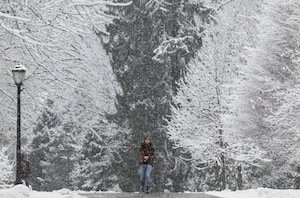College Community Perseveres Through Winter Onslaught

Time and time again, Mother Nature attacked the eastern coast of the United States, ringing in the New Year and spring school semester with feet of snow, power outages, and icy conditions. The wintery onslaught has seemed near-constant since Swarthmore students started to trickle back to campus in mid-January.
Every time the College managed to shovel itself out, another storm would hit, burying us once more. On several occasions, the College was forced to shut down, sending all non-essential personnel home and directing students to review the inclement weather policy. Security, facilities, and dining services staff worked wire to wire to meet the needs of the community.
Although the vast majority of Northeast schools closed in the face of the storms, Swarthmore's deans reminded students that classes would not be cancelled. Widespread misery poker ensued. Students gathered in common places, frantically comparing their dire situations with those of their friends and checking their emails. When their batteries waned, students vied for precious few power outlets. Some took creative approaches, with Sam Cleaves '14 and friends bringing a power strip to Sharples Dining Hall as a bartering chip.
For the most part, the show went on, though not everything ran smoothly. Visiting Assistant Professor of Economics Vera Brusentsev tried to draw PowerPoint content on the blackboard, but her students could not see it. By most accounts, attendance was strong, in true Swattie fashion, but the atmosphere subdued.
"The general feeling of class was noticeably restless," says Lanie Schlessinger '15, an English literature major from Deerfield, Ill.
Other economics students had better success with a high-tech option, giving seminar presentations over iPhones. Classes continued as planned in history and Japanese, among others.

The power outage vexed the Biology Department, in particular, but its faculty and students persevered. Visiting Assistant Professor Jason Downs couldn't use the slides he prepared, so he gave a "chalk talk" in the twilight of Bio 2, his only visual aid a human skeleton.
The window light of the Bio 2 lab sufficed for a mink dissection, but another dissection was moved to the Speer lab and its lamps plugged into emergency power. For his developmental biology lab, Assistant Professor Brad Davidson dashed out to gather enough LED flashlights to illuminate microscopes.
"What a day," says Visiting Assistant Professor Gabriel Rivera, who managed to fill two hours of seminar thanks to a 200-foot extension cord from a colleague. "I've been to a lot of places and have never seen [anything like it]. I was impressed by the way everyone found a way to make things work."
The situation and the restlessness that accompanied it were reminiscent of Hurricane Sandy, once again forcing students together, making the Swarthmore bubble seem even smaller. Schlessinger took refuge in the Science Center commons, taking advantage of the natural light and an upside of the outage: "half-priced sushi and Indian food!" Others congregated in Sharples and McCabe Library, which quickly became loud and overcrowded, before other options emerged.
"The super-amazing snack bar staff will open Essie Mae's at 6 p.m. to serve you," Linda McDougall, dining services director, informed students via email the afternoon of the Tues., Feb. 13, snow closure. "Please walk around campus safely as night falls."
Apart from affecting students' looming seminar papers and problem sets, the snow and power outages wrought havoc on basic needs like eating and showering. The lack of power choked the hot water supply.
"You don't realize just how important the power is until it's gone," Schlessinger says.
Olivia Perez '15, a neuroscience major from Caldwell, N.J., decided to escape the situation altogether - she and some friends took the still-operating SEPTA train to dinner in center city.
"I just felt like I had to escape the Swarthmore bubble," says Perez. "It gets even smaller when there is no electricity."

Still, a wide swath of the community reflects on the situation warmly. Kayla Moritzky '14 and women's basketball teammates relay a glass-half-full perspective on the power outage, which preceded an away game at nearby Ursinus College.
"We don't normally like going to away games, but this time we considered ourselves lucky," Moritzky says. "We were able to charge our phones in the Ursinus locker room and shower there after the game."
For Professor and Chair of Biology Amy Vollmer, the collaborative, can-do response to the power outage reveals the essence of Swarthmore.
"I am basking in the reflected light that my colleagues and student cast," she says, before offering a slogan for this year's department t-shirt:
"Where did you go when the lights went out? I went to bio lab!"

